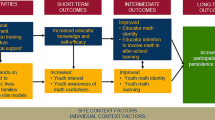Abstract
This article reports the results of a national survey of mathematics achievement at the end of primary school in Vietnam. A sample of more than 72000 students were assessed from 61 provinces. The items were matched to the Vietnam Mathematics curriculum for Year 5 students. Using a skills audit of the items, a variable of Vietnamese mathematics development was defined following an item response analysis of the data. Findings reveal that the levels of mathematics achievement were relatively high and that the mathematics curriculum was closely aligned with international trends in mathematics for primary school. There were some areas of concern in that lower achievement levels were persistently aligned with low socio economic groups and these were typically located in three regions of Vietnam, heavily populated by ethnic sub-groups.
Similar content being viewed by others
References
Adams, R. J., & Khoo, S. T. (1995). Quest Interactive Item Analysis Software [Computer software]. Melbourne: ACER.
Andrich, D. (2002). RUMM: A Rasch Model Analysis Program. Perth: University of Western Australia.
Angoff, W. H. (1971). Scales, norms and equivalent scores. In R. L. Thorndike (Ed.),Educational measurement (pp. 508–600). Washington, DC: American Council on Education.
Barro, R. J. (2001). Human capital and growth.American Economic Review, 91(2), 12–17.
Bloom, B. S. (1956).Taxonomy of educational objectives, Handbook 1: The Cognitive Domain. New York: Longman.
Coleman, J. S. (1994). Family, school and social capital. In T. Husén & T.N. Postlethwaite (Eds.),International encyclopedia of education. Oxford: Pergamon.
Glaser, R. (1963). Instructional technology and the measurement of learning outcomes: Some questions.American Psychologist, 18, 519–521.
Glaser, R. (1981). The future of testing: A research agenda for cognitive psychology and psychometrics.American Psychologist, 36, 923–936.
Glaser, R. (1990). Expertise. In M. W. Eysenk, A. N. Ellis, E. Hunt, & P. Johnson-Laird (Eds.),The Blackwell dictionary of cognitive psychology. Oxford, England: Blackwell.
Greaney, V., Khandker, S. R., & Alam, M. (1999).Bangladesh: Assessing basic skills. Dhaka: University Press Ltd.
Griffin, P. (1990) Profiling literacy development. Monitoring children’s growth towards literacy.Australian Journal of Education, 34, 290–311.
Griffin, P. (1998).Vietnamese national study of pupil achievement in mathematics and Vietnamese. Hanoi: National Institute for Education and Science.
Griffin, P. (1999).Vietnam primary school monitoring report. (Mimeographed report). Vietnam: World Bank.
Griffin, P. (2005). The development and calibration of student and teacher tests of achievement in Vietnam. In T. N. Postlethwaite (Ed.),Achievement levels of Vietnamese grade five students (Vol. 2, chap. 2). Hanoi: World Bank in Vietnam.
Griffin, P. (In press). Linking pupil and teacher competence in reading and mathematics in Vietnam. Educational Research for Policy and Practice.
Griffin, P., Smith, P., & Ridge, N. (2001).The literacy profiles in practice: An assessment approach. Portsmouth: Heinemann.
Lord, F. M. (1980).Applications of item response theory to practical testing problems. Hillsdale, NJ: Lawrence Erlbaum.
Messick, S. M., Beaton, A.E., & Lord, F.M. (1983).NAEP reconsidered: A new design for a new era. Princeton, NJ: Educational Testing Service.
Murimba, S., Nzomo, J., Keitheile, M., Leste, A., Ross, K., Saito, M., et al. (2002).Monitoring the quality of Education for All: Some examples of different approaches used by The Southern Africa Consortium for Monitoring Educational Quality. Dar-es-Salaam, Tanzania: SACMEQ Ministers of Education at MINEDAF VIII Meeting.
Postlethwaite, T. N., (Ed.). (2005).Achievement levels of Vietnamese grade five students. (Vol. 1, 2, and 3). Hanoi: World Bank in Vietnam.
Ross, K. N., Saito, M., Dolata, S., & Ikeda, M. (2005). Sample design procedures: The Vietnam grade five survey. In T. N. Postlethwaite (Ed.),Achievement levels of Vietnamese grade five students. (Vol 1, 2, and 3). Hanoi: World Bank in Vietnam.
Wilson, M. (1999). Measurement of developmental levels. In G. N. Masters & J. P. Keeves (Eds.),Advances in measurement in educational research and assessment. New York: Pergamon.
Wu, M., Adams, R. J., & Wilson, M. (1998). ConQuest: Generalised item response modelling software [Computer software]. Melbourne: ACER.
Author information
Authors and Affiliations
Corresponding author
Additional information
The views expressed in this paper are those of the authors and do not claim to represent the views of the Vietnamese Government in any way. The article is based on a World Bank project (in Vietnam) on achievement at the end of primary school.
Rights and permissions
About this article
Cite this article
Griffin, P. Mathematics achievement of vietnamese grade 5 pupils. Asia Pacific Educ. Rev. 8, 233–249 (2007). https://doi.org/10.1007/BF03029259
Received:
Revised:
Accepted:
Issue Date:
DOI: https://doi.org/10.1007/BF03029259




